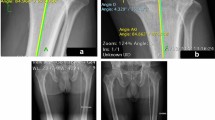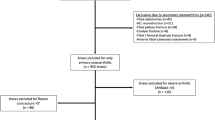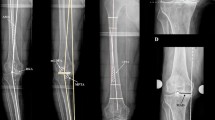Abstract
Objective
The aim of this observational study was to investigate the postoperative alignment change with Oxford unicompartmental knee arthroplasties (UKA), and clarify whether femoro-tibial facet angle (FTFA) is useful for evaluating alignment correctability with UKA.
Methods
This study evaluated 79 knees consecutive minimally invasive Oxford phase 3 UKAs performed between 2013 and 2014. Full-length weight-bearing radiographs of the lower limbs were obtained pre- and postoperatively to assess varus angle. Preoperative valgus stress radiography in the supine position was also performed. FTFA was measured on weight-bearing anteroposterior radiography and valgus stress radiography.
Results
The preoperative varus angle of 4.6° ± 3.1° reduced to 1.7° ± 2.6° postoperatively. Preoperative varus angle and postoperative varus angle change strongly correlated with the FTFA value and its change on the valgus stress radiographs, respectively (p < 0.01). Based on preoperative FTFA under valgus stress radiography, intra-articular varus corrected group (37 knees) with preoperative varus angle 2.9° ± 2.4° was corrected to − 0.3° ± 2.0° after UKA. However, intra-articular varus uncorrected group (42 knees) with preoperative varus angle 6.0° ± 3.0° was only corrected to 3.5° ± 1.7°. Thirteen knees (16.5%) were overcorrected to valgus after UKA, with a mean FTFA of − 1.2° ± 0.4° under valgus stress force, which related with a postoperative valgus angle 0.8° ± 1.2°.
Conclusion
FTFA change under valgus stress force was useful for evaluating the correctability of UKA. It could reflect intra-articular varus deformity. Intra-articular varus deformity not corrected under valgus stress would result in varus after UKA. However, intra-articular deformity which could be overcorrected under valgus stress would have a tendency to valgus after Oxford UKA.



Similar content being viewed by others
References
Berger RA, Della VC (2010) Unicompartmental knee arthroplasty: indications, techniques, and results. Instr Course Lect 59:47–56
Lisowski LA, van den Bekerom MP, Pilot P, van Dijk CN, Lisowski AE (2011) Oxford Phase 3 unicompartmental knee arthroplasty: medium-term results of a minimally invasive surgical procedure. Knee Surg Sports Traumatol Arthrosc 19:277–284
Price AJ, Dodd CA, Svard UG, Murray DW (2005) Oxford medial unicompartmental knee arthroplasty in patients younger and older than 60 years of age. J Bone Joint Surg Br 87:1488–1492
Svard UC, Price AJ (2001) Oxford medial unicompartmental knee arthroplasty. A survival analysis of an independent series. J Bone Joint Surg Br 83:191–194
Aleto TJ, Berend ME, Ritter MA, Faris PM, Meneghini RM (2008) Early failure of unicompartmental knee arthroplasty leading to revision. J Arthroplasty 23:159–163
Zhang Q, Zhang Q, Guo W, Liu Z, Cheng L, Yue D, Zhang N (2014) The learning curve for minimally invasive Oxford phase 3 unicompartmental knee arthroplasty: cumulative summation test for learning curve (LC-CUSUM). J Orthop Surg Res 9:81
Hernigou P, Deschamps G (2004) Alignment influences wear in the knee after medial unicompartmental arthroplasty. Clin Orthop Relat Res (423):161–165
Kim KT, Lee S, Kim TW, Lee JS, Boo KH (2012) The influence of postoperative tibiofemoral alignment on the clinical results of unicompartmental knee arthroplasty. Knee Surg Relat Res 24:85–90
Kim SJ, Bae JH, Lim HC (2012) Factors affecting the postoperative limb alignment and clinical outcome after Oxford unicompartmental knee arthroplasty. J Arthroplasty 27:1210–1215
Bruni D, Iacono F, Russo A, Zaffagnini S, Marcheggiani MG, Bignozzi S, Bragonzoni L et al (2010) Minimally invasive unicompartmental knee replacement: retrospective clinical and radiographic evaluation of 83 patients. Knee Surg Sports Traumatol Arthrosc 18:710–717
Tashiro Y, Matsuda S, Okazaki K, Mizu-Uchi H, Kuwashima U, Iwamoto Y (2014) The coronal alignment after medial unicompartmental knee arthroplasty can be predicted: usefulness of full-length valgus stress radiography for evaluating correctability. Knee Surg Sports Traumatol Arthrosc 22:3142–3149
Murray DW (2005) Mobile bearing unicompartmental knee replacement. Orthopedics 28:985–987
Marx RG, Grimm P, Lillemoe KA, Robertson CM, Ayeni OR, Lyman S, Bogner EA et al (2011) Reliability of lower extremity alignment measurement using radiographs and PACS. Knee Surg Sports Traumatol Arthrosc 19:1693–1698
Moreland JR, Bassett LW, Hanker GJ (1987) Radiographic analysis of the axial alignment of the lower extremity. J Bone Joint Surg Am 69:745–749
Nayak BK, Hazra A (2011) How to choose the right statistical test? Indian J Ophthalmol 59:85–86
Thienpont E, Parvizi J (2016) A New Classification for the Varus Knee. J Arthroplasty 31:2156–2160
Maderbacher G, Baier C, Springorum HR, Zeman F, Grifka J, Keshmiri A (2016) Lower limb anatomy and alignment affect natural tibiofemoral knee kinematics: a cadaveric investigation. J Arthroplasty 31:2038–2042
White SH, Ludkowski PF, Goodfellow JW (1991) Anteromedial osteoarthritis of the knee. J Bone Joint Surg Br 73:582–586
Ahlback S (1968) Osteoarthrosis of the knee. A radiographic investigation. Acta Radiol Diagn (Stockh) Suppl 277:7–72
Mullaji AB, Marawar SV, Luthra M (2008) Tibial articular cartilage wear in varus osteoarthritic knees: correlation with anterior cruciate ligament integrity and severity of deformity. J Arthroplasty 23:128–135
Moschella D, Blasi A, Leardini A, Ensini A, Catani F (2006) Wear patterns on tibial plateau from varus osteoarthritic knees. Clin Biomech (Bristol Avon) 21:152–158
Kendrick BJ, Simpson DJ, Kaptein BL, Valstar ER, Gill HS, Murray DW, Price AJ (2011) Polyethylene wear of mobile-bearing unicompartmental knee replacement at 20 years. J Bone Joint Surg Br 93:470–475
Mullaji AB, Shetty GM, Kanna R (2011) Postoperative limb alignment and its determinants after minimally invasive Oxford medial unicompartmental knee arthroplasty. J Arthroplasty 26:919–925
Wyss TF, Schuster AJ, Munger P, Pfluger D, Wehrli U (2006) Does total knee joint replacement with the soft tissue balancing surgical technique maintain the natural joint line? Arch Orthop Trauma Surg 126:480–486
Sim JA, Lee YS, Kwak JH, Yang SH, Kim KH, Lee BK (2013) Comparison of complete distal release of the medial collateral ligament and medial epicondylar osteotomy during ligament balancing in varus knee total knee arthroplasty. Clin Orthop Surg 5:287–291
Thienpont E, Schwab PE, Cornu O, Bellemans J, Victor J (2017) Bone morphotypes of the varus and valgus knee. Arch Orthop Trauma Surg 137(3):393–400
Funding
This study was funded by “the capital health research and development of special” (Grant number 2016-2-4062) and National Natural Science Foundation of China (grant number 81703896).
Author information
Authors and Affiliations
Corresponding author
Ethics declarations
Conflict of interest
The authors declare that they have no conflict of interest.
Ethical approval
All procedures performed in studies involving human participants were in accordance with the ethical standards of the institutional and/or national research committee and with the 1964 Helsinki declaration and its later amendments or comparable ethical standards.
Rights and permissions
About this article
Cite this article
Zhang, Q., Yue, J., Wang, W. et al. FTFA change under valgus stress force radiography is useful for evaluating the correctability of intra-articular varus deformity in UKA. Arch Orthop Trauma Surg 138, 1003–1009 (2018). https://doi.org/10.1007/s00402-018-2945-6
Received:
Published:
Issue Date:
DOI: https://doi.org/10.1007/s00402-018-2945-6




